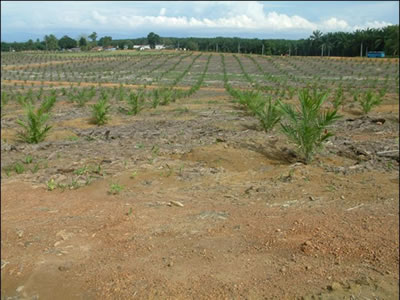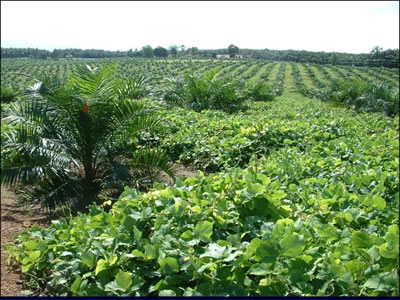IMPHOS Project: Phosphate Fertiliser Management in Oil Palm Plantation in Malaysia
Phosphate deficiencies is a major factor in declining crop production in many acidic soils in developing countries in the tropics, where the soils are either inherently low in soil P or they are present in forms that are unavailable to plants. These conditions are found in Malaysian soils where oil palms are extensively cultivated. Recent work has shown that phosphate rocks with the right chemical and physical properties can be effective P sources for oil palm if various agronomic factors e.g. sufficient organic matter and living green manure, adequate rainfall and appropriate management are in place. The primary project objectives are:
- To evaluate suitable and cost effective P fertiliser sources for oil palms grown on different soil types and ecological zones in Malaysia
- To study the management practices for P fertiliser application to increase P use efficiency
- To study the effects of organic residue amendments and management (legume covers, empty fruit bunches, cut fronds and palm oil mill effluent) on P fertiliser use by oil palm
- To evaluate methods of fertilizer and soil P analysis and correlate with P uptake and yield of oil palm
- To measure residual P availability in relation to soil P fractions, leaf P content and fresh fruit bunch (FFB) yield
- To study the soil P pools and processes affecting PR dissolution and P availability

Briefing on trial progress and results by Patrick Ng, AAR, at Batu Lintang estate, Kedah. (From left to right (clockwise)): Lee chin Tui (Felda), Ilangovan, K. (Felda), Assoc. Prof. Dr. Mohd. Hanafi Musa (UPM), Teo Chor Boo (AAR), Chang Ah Kow (Tradewinds), Nga Shee Kiong (Felda), Dr. Zulkifli Hashim (MPOB), Shaharudin Bakar (Golden Hope), Prof. Dr. Zaharah Abdul Rahman (UPM) and Patrick Ng (AAR).
Some early results are:
| P concentrations of Mucuna bracteata(MB) responded linearly to phosphate rock up to 97 kg P ha-1 whereas no significant response was obtained for Pueraria javanica (PJ). |
One month after planting the oil palm
 13 months after planting the oil palm
 |
| MB planted with PJ showed significantly higher mean P concentration of 0.141% compared with pure MB of 0.117%. | |
| This symbiotic effect might be attributed to the rapid ground coverage of PJ which would reduce erosion and run-off losses of applied PR and solubilize PR with consequent higher P availability to MB. | |
| For further details, see Ng P.H.C., Goh K.J., Gan H.H. and Zaharah, A.B. (2005). Impact of phosphate rock on P uptake and dry matter production of mixed legumes under oil palm in Malaysia. In: Li, C.J. et al. (eds) In: Proc. XV International Plant Nutrition Colloquium on Plant Nutrition For Food Security, Human Health And Environmental Protection, Tsinghua University Press, Beijing, China: 1124-1125. |
